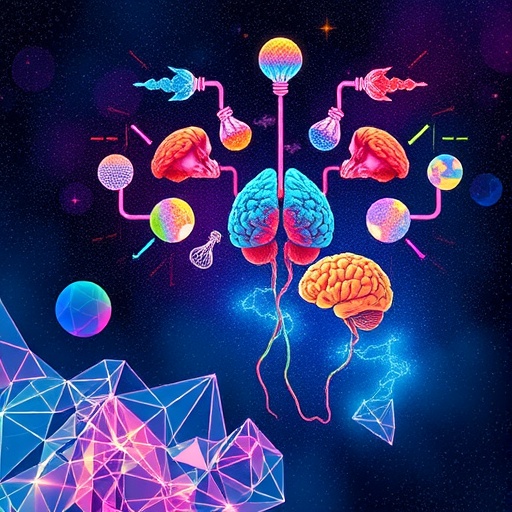In a groundbreaking peer-reviewed viewpoint published this month in the journal Psychedelics, Professor Xiaohui Wang and colleagues present a comprehensive synthesis exploring the profound therapeutic potential of psychedelic substances in treating stress-related psychiatric disorders. This article meticulously examines emerging neurobiological mechanisms through which compounds such as psilocybin, lysergic acid diethylamide (LSD), and 3,4-methylenedioxymethamphetamine (MDMA) offer transformative prospects for conditions marked by chronic stress, including major depressive disorder, anxiety, and posttraumatic stress disorder (PTSD).
Chronic stress exerts a pervasive and deleterious impact on brain structure and function, principally via sustained activation of the hypothalamic-pituitary-adrenal (HPA) axis. This persistent neuroendocrine dysregulation precipitates neuronal remodeling and synaptic deficits in key regions governing mood and cognition. Traditional pharmacological interventions, predominantly selective serotonin reuptake inhibitors (SSRIs), and psychotherapeutic modalities such as cognitive behavioral therapy, although beneficial for subsets of patients, frequently leave a substantial proportion with refractory symptoms or intolerable side effects. Against this backdrop, psychedelics have reemerged as a promising avenue, rekindling scientific inquiry long dormant since regulatory barriers imposed in the late 20th century.
Central to their mechanism of action is the potent agonism of serotonin 2A (5-HT2A) receptors, which are densely expressed in cortical areas implicated in emotional regulation and higher-order cognitive functions. Activation of these receptors initiates complex intracellular cascades that culminate in enhanced neuroplasticity. Notably, preclinical models reveal that psilocybin elevates brain-derived neurotrophic factor (BDNF) levels and promotes dendritic arborization within the prefrontal cortex. These neuroplastic adaptations are critical, as they restore synaptic connectivity disrupted by chronic glucocorticoid exposure, offering a biological substrate for sustained mood improvement.
Clinically, an accumulating corpus of evidence underscores the durable efficacy of psychedelic-assisted therapies. Psilocybin, administered in controlled settings, has demonstrated remarkable antidepressant effects in individuals unresponsive to conventional treatments, with symptom remission extending several months post-intervention. Of particular note, MDMA-assisted psychotherapy has yielded profound reductions in PTSD symptomatology, with approximately two-thirds of participants no longer meeting diagnostic criteria following treatment. Nonetheless, regulatory authorities including the FDA have cautioned regarding methodological limitations inherent in current trials, emphasizing the necessity for rigorous, large-scale investigations with refined protocols.
The authors advance an insightful conceptualization that psychedelics do more than transiently ameliorate symptoms; they catalyze neurobiological processes that may underpin fundamental recovery. By fostering a neuroplastic milieu, these compounds facilitate the reprocessing and integration of entrenched traumatic memories and stressors, potentially obviating relapse common with standard treatments. This paradigm shift from symptomatic palliation to mechanistic restoration heralds a new frontier in psychiatric care.
Beyond serotonergic modulation, burgeoning evidence implicates psychedelics in attenuating neuroinflammation, a pathophysiological axis increasingly recognized in stress-related disorders. Psilocybin appears to downregulate pro-inflammatory cytokines, which may otherwise perpetuate neural damage. The authors advocate for concurrent biomarker assessments—encompassing both immune parameters and cortisol dynamics—to elucidate the interplay between these mechanisms and optimize therapeutic strategies.
Distinct from classical psychedelics, MDMA’s therapeutic efficacy is attributed to its entactogenic profile mediated through monoamine release, engendering heightened emotional openness and attenuated fear responses. This pharmacodynamic state enhances memory reconsolidation during psychotherapy, enabling patients to confront traumatic content without overwhelming distress, thus reinforcing lasting psychological gains.
Despite these promising advances, the article does not shy away from the formidable challenges impeding mainstream adoption. The entrenched Schedule I classification poses significant barriers to research and clinical implementation, though evolving legislative experiments in jurisdictions like Oregon and Colorado signal gradual shifts towards regulated frameworks. The necessity of specialized clinician training, given the unique therapeutic milieu and psychological effects, is underscored as essential for safe and effective administration.
Safety considerations remain paramount. Common acute adverse effects such as nausea, headache, and transient cardiovascular changes require meticulous screening and intra-session monitoring. The authors recommend standardization of clinical protocols, enhanced adverse event reporting, and innovative methodological approaches to mitigate expectancy biases that can confound efficacy assessments. Moreover, longitudinal comparative studies contrasting psychedelic-assisted therapy with established interventions across diverse psychiatric populations are crucial to delineate long-term outcomes.
Looking ahead, Prof. Wang and colleagues delineate critical frontiers for future research. Precision medicine approaches, including development of predictive biomarkers and identification of genetic moderators, could personalize dosing and optimize patient selection. Additionally, interdisciplinary collaboration spanning neuroscience, psychology, bioengineering, and pharmacology is vital to unravel the complex neural circuitry and molecular pathways modulated by psychedelics.
This synthesized viewpoint serves as a pivotal resource, weaving together historical context, mechanistic insights, clinical realities, and policy considerations into a coherent framework. It equips researchers, clinicians, and policymakers with a nuanced understanding requisite for responsibly harnessing psychedelics’ therapeutic promise. The authors’ integrative analysis highlights patterns and contradictions across the literature, illuminating the most auspicious avenues for advancing this rapidly evolving domain.
In summary, the resurgence of psychedelic research marks a renaissance in psychiatric therapeutics. By engaging serotonin 2A receptor-mediated neuroplasticity, mitigating neuroinflammation, and facilitating profound psychotherapeutic processes, these compounds offer a novel means to counterbalance the pernicious effects of chronic stress. While substantive challenges remain, including regulatory constraints, safety management, and the need for rigorous clinical validation, the horizon for mental health treatment is undeniably expanding, catalyzed by these powerful agents.
The full peer-reviewed viewpoint, entitled “Psychedelics in the context of stress and psychiatric disorders: A new horizon in mental health treatment,” is openly accessible in Psychedelics as of 29 September 2025. This article epitomizes the dynamic intersection of cutting-edge science and clinical innovation, promising to reshape the landscape of mental health care in the decades to come.
Subject of Research: People
Article Title: Psychedelics in the context of stress and psychiatric disorders: A new horizon in mental health treatment
News Publication Date: 14-Oct-2025
Web References:
http://dx.doi.org/10.61373/pp025v.0038
Image Credits: XiaohuiWang
Keywords
Psychedelics, 5-HT2A receptor, neuroplasticity, brain-derived neurotrophic factor, psilocybin, MDMA, stress, psychiatric disorders, PTSD, depression, neuroinflammation, therapeutic mechanisms
Tags: alternatives to SSRIs in depressionchronic stress impact on mental healthcognitive behavioral therapy limitationsinnovative treatments for anxietyLSD in mental health treatmentMDMA and PTSD therapyneurobiological mechanisms of psychedelicspsilocybin for stress reliefpsychedelic therapy for psychiatric disordersserotonin 2A receptor agonismstress-related psychiatric disorder treatmentstherapeutic potential of psychedelics





